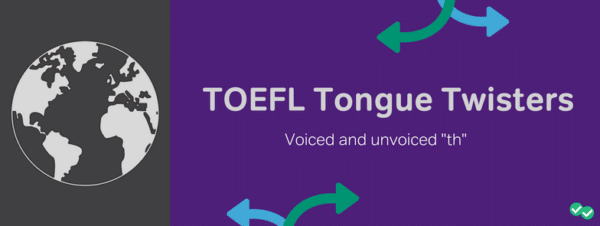
Looking to improve on the TOEFL Speaking section? We’re here to help! Today we’re going to practice some English tongue twisters—mini-speeches that help you practice a sound over and over. We’ll focus on “th” in English.
Examples of Voiced and Unvoiced “TH”
There are two “th” sounds in English: an “unvoiced” th and a “voiced” one. The voiceless “th” sound is made without using vocal cords. This sound is common in most words that begin with “th.” “Think,” “third,” and “thank” all start with the voiceless “th.”
In the voiced “th,” English speakers use their vocal cords while they make the “th” sound. This is heard in nearly all structure words in English that begin with “th.” By “structure words,” I mean words whose purpose is mostly grammatical. Structure words that begin with the voiced “th” sound include “the,” “those,” “that,” “this,” “than,” and others.
Before we do some tongue twisters for pronouncing these two variations of “th,” let’s make sure you can hear the difference.
Listen to me say the word “thistle,” which has a voiceless “th” at the beginning:
THISTLE:
Now listen to my audio of “this,” a grammatical word that starts with voiced “th:”
THIS
Can you hear the difference between the “th” sounds at the beginnings of these two similar words? If not, then listen again. This time, I’ll go more slowly when I say the beginning “th” sound in the words:
THISTLE, THIS
By now, you probably can hear the difference. But just in case, let’s listen to these two words one more time. I’ll say the “th” sounds even more slowly:
THISTLE, THIS (very slowly)
You definitely heard the difference that time, right? To master these two English “th” sounds, the next step is to say them yourself. This is where tongue-twisters come in!
Tongue Twisters with Voiced and Unvoiced “TH”
To get started, read this tongue twister out loud:
- this thin that thatch these themes those thorns the thug they thank
How did you do? Were you able to say the two English “th” sounds differently and distinctly? Check your own speech by listening to my example recording of the twelve words above:
TONGUE TWISTER: MINIMAL PARIS WITH “TH”
Now, let’s try a real tongue twister– a complete sentence that uses both “th” sounds a lot:
- They thankfully think this thing is the best thing that they can throw the three times they need to throw a thing.
Read that sentence out loud a few times to practice English “th.” And again, you can check your work by listening to one of my recordings:
TONGUE TWISTER: VOICED AND VOICELESS TH
These activities should help you build some real skills for saying and hearing “th” in English. In my next tongue-twister post, we’re going to look at a related pair of sounds in English: the voiced “th” sound and the “L” sound.
Looking for More Help?
You can practice the TOEFL Speaking section under test-like conditions in our free TOEFL practice test. Take a complete TOEFL practice exam or just practice a mock Speaking section based on your goals. Looking for more help? You can get a free trial of the Magoosh Premium Plan today! The Premium Plan has helped countless TOEFL students over the years and contains best-in-class practice questions and explanations. Let us help you surpass your score goals and get into the program of your dreams!





